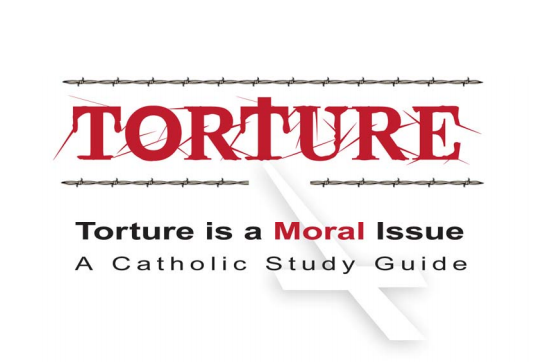 Torture is a moral issue – US Bishops Study Guide – In these challenging times, is it still possible—even in the face of serious threats—for a people and a nation to defend and conduct themselves in ways that consistently demonstrate respect for human dignity, and that put the Gospel into practice?
Torture is a moral issue – US Bishops Study Guide – In these challenging times, is it still possible—even in the face of serious threats—for a people and a nation to defend and conduct themselves in ways that consistently demonstrate respect for human dignity, and that put the Gospel into practice?
Waterboarding? Electric Shocks? References to torture can be found in newspapers, radio and TV programs, and even in cartoons. What does the Church have to say about torture? This four chapter study guide will offer reflections on torture as a moral issue. Get a group together to discuss this timely issue and what you can do to stop torture.
Catholics enter into the public discussion of the great issues their society faces because they hope to contribute—in the light of faith—to resolving these issues. There is, in addition, the confidence that people of faith can contribute in highly positive ways to building up and transforming the world around them.
With that in mind, two basic convictions give shape to this discussion guide from the US Catholic Bishops:
— First, that torture is a moral issue, one that deserves to be understood and addressed by Christians.
— Second, that an atmosphere of fear and desperation within society opens the door to the torture and abuse of prisoners, but that there is much Christians can do to help create a new atmosphere within society – an atmosphere in which respect for human dignity rules the day.
Thus, this discussion guide examines torture within the larger context of Catholic social teaching in an era of globalization. That is why each of our four chapters includes, in addition to its main point of discussion, the exploration of a positive way to help create a new atmosphere within our society and even in the larger world.
Torture Is A Moral Issue: A Study Guide
Download the entire study guide as a PDF
What has Pope Benedict XVI said about the use of torture in prisons? What does the Compendium of the Social Doctrine of the Church. . . . . . say about this? Have the Catholic bishops of the United States spoken out on torture? You’ll find answers to questions like those in the chapters that follow, along with reflections on torture and prisoner abuse by numerous Catholic bishops, theologians, and other commentators.
Chapter 1 is devoted to Catholic thought on the dignity of every human person. For when Catholic leaders today turn attention to the use of torture in prisons of any kind anywhere in the world, they consistently view it as a violation of the human person’s God-given dignity.
Chapter 2 focuses on torture itself, and the reasons why it is a source of such concern for the Church at this point in the third millennium. What forms does torture take? What reasons are given for the torture or abusive treatment of prisoners today? What specific objections are lodged by Catholic leaders against torture?
Chapter 3 closely examines Jesus’ Gospel instruction to love our enemies. Is it actually possible to love enemies in these threatening times of terrorism? Is it possible to love an enemy who may harbor information we seek to defend ourselves? The teaching of the Gospel on love for our enemies is not easy to follow, but Catholic leaders tell in this chapter why they view it as a teaching of utmost seriousness.
Chapter 4 is designed to promote discussion of actions that individuals, families, small groups in parishes, schools and others might take to address the issue of torture, and to raise awareness of its importance as a moral matter.
Finally, in an appendix to this discussion guide, you’ll find the text of a letter written in late 2007 by Bishop Thomas G. Wenski, Chairman of the Committee on International Justice and Peace of the United States Conference of Catholic Bishops, to members of the Senate. This appendix serves as a valuable overview of the Church’s reasons for opposing torture
Building a culture of life as an antidote to a culture in which human dignity often goes unrecognized is a key element of chapter 1.
Bringing the virtue of hope back into a society pervaded by fear and anxiety is a key element of chapter 2.
Striving to become a genuine people of the Beatitudes is a key element of chapter 3.
Participating in interreligious dialogue, fasting for justice and peace, praying for enemies, overcoming evil with goodness, and advocating for the abolition of torture are among the actions proposed in chapter 4.







*** The painfully slow process of uncovering the child abuse that happened within the Catholic Church continues. The members of the church continue to try and protect the wrong people, at the expense of victims, their families and the American people. ***
The Archdiocese of Chicago has voluntarily released documents related to 36 Archdiocesan priests who have at least one substantiated allegation of sexual misconduct with a minor. These documents are in addition to those released in January on 30 other priests. This release, together with the January release, covers priests who have substantiated allegations of sexual misconduct with minors identified on the Archdiocese’s website as of November 2014. Documents pertaining to two priests, former Rev. Daniel J. McCormack and Rev. Edward J. Maloney, are not included, due to ongoing processes that do not permit release.
Inquiries may be directed to the Office of the Protection of Children and Youth, Archdiocese of Chicago, PO Box 1979, Chicago, IL 60690. Contact them!!!
America! America!
God mend thine every flaw,
Confirm thy soul in self-control,
Thy liberty in law!